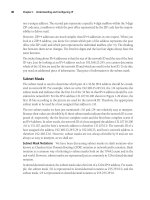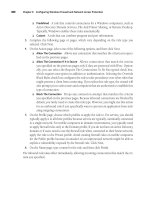Lecture Configuring and troubleshooting a Windows Server 2008 Network Infrastructure - Module 11
Bạn đang xem bản rút gọn của tài liệu. Xem và tải ngay bản đầy đủ của tài liệu tại đây (3.24 MB, 51 trang )
Configuring and Managing Distributed File System
11-1
Module 11
Configuring and Managing Distributed File
System
Contents:
Lesson 1: DFS Overview
11-3
Lesson 2: Configuring DFS Namespaces
11-15
Lesson 3: Configuring DFS Replication
11-25
Lab: Configuring DFS
11-39
11-2
Configuring and Managing Distributed File System
Module Overview
Many organizations have the challenge of maintaining a large number of users and
servers that are often distributed throughout geographically dispersed locations. In
these situations, administrators must find ways to ensure that users can locate files
as quickly as possible. Managing multiple sites often introduces additional
challenges, such as limiting network traffic over slow wide area network (WAN)
connections, ensuring the availability of files during WAN or server failures, and
backing up file servers that are located at smaller branch offices.
This module introduces the Distributed File System (DFS) solution that can be
used to address these challenges by providing fault-tolerant access and WANfriendly replication of files located throughout the enterprise.
Configuring and Managing Distributed File System
11-3
Lesson 1
DFS Overview
Administrators who manage file servers throughout an enterprise require methods
to provide efficient access to resources and ensure availability of files. DFS in
Windows Server 2008 provides two technologies to help address these challenges;
DFS Replication and DFS Namespaces. This lesson introduces these two
technologies and provides scenarios and requirements for deploying a DFS
solution within your network environment.
11-4
Configuring and Managing Distributed File System
What is the Distributed File System?
Key Points
DFS technologies in Windows Server 2008 provide a simplified way to access
geographically dispersed files throughout an organization. DFS also provides
WAN-friendly file replication between servers. Technologies provided with DFS
include:
•
DFS Namespaces
•
DFS Replication
•
Remote Differential Compression
Question: Which two technologies make up DFS?
Question: Which technology is used to replicate files within a Windows Server
2008 environment?
Configuring and Managing Distributed File System
11-5
Additional Reading
•
Distributed File System Technology Center
•
Overview of the Distributed File System Solution in Microsoft Windows Server
2003 R2
•
Microsoft Distributed File System - IT Value Card
•
About Remote Differential Compression
•
Optimizing File Replication over Limited-Bandwidth Networks using Remote
Differential Compression
11-6
Configuring and Managing Distributed File System
How DFS Namespaces and DFS Replication Work
Key Points
Even though DFS Namespaces and DFS Replication are separate technologies,
both can be used together to provide high availability and redundancy of data.
The following process describes how DFS Namespaces and DFS Replication work
together:
1.
User accesses folder in the configured namespace.
2.
Client computer accesses the first server in the referral.
Configuring and Managing Distributed File System
11-7
Additional Reading
•
Overview of the Distributed File System Solution in Microsoft Windows Server
2003 R2
•
Distributed File System: Frequently Asked Questions
•
Distributed File System Replication: Frequently Asked Questions
•
Distributed File System Management Help: Overview of DFS Namespaces
11-8
Configuring and Managing Distributed File System
DFS Scenarios
Key Points
There are a number of key scenarios that can benefit from DFS Namespaces and
DFS Replication. These scenarios include:
•
Sharing files across branch offices
•
Data collection
•
Data distribution
Question: How can you use DFS technologies within your organization?
Additional Reading
•
Overview of the Distributed File System Solution in Microsoft Windows Server
2003 R2
Configuring and Managing Distributed File System
11-9
Types of DFS Namespaces
Key Points
When creating a namespace, you create either a domain-based namespace or a
stand-alone namespace. Each type of namespace has different characteristics.
A domain-based namespace can be used when:
•
High-availability of the namespace is required.
•
You need to hide the name of the namespace servers from the users.
A stand-alone namespace is used when:
•
Your organization has not implemented Active Directory® directory service.
•
Your organization does not meet the requirements for a Windows Server 2008
mode domain-based namespace, and you have requirements for more than
5,000 DFS folders.
11-10
Configuring and Managing Distributed File System
Question: How can you be sure that users are not traversing a slow WAN
connection to access a DFS Namespace root?
Additional Reading
Help Topic: Distributed File System Management: Choosing a Namespace Type
Configuring and Managing Distributed File System
11-11
What are Folders and Folder Targets?
Key Points
Within a DFS namespace you create one or more folders. These folders contain
one or more folder targets.
•
Folders. Folders are the primary elements of a namespace.
•
Folder targets. A folder target is a Universal Naming Convention (UNC) path
to one of the following locations:
•
A shared folder.
•
A folder within a shared folder.
•
A path to another namespace.
Question: What is the DFS namespace hierarchy?
Additional Reading
•
DFS Management
11-12
Configuring and Managing Distributed File System
Namespace Server Requirements
Key Points
A namespace server is a domain controller or member server that hosts a DFS
Namespace. The number of namespaces that a server can host is determined by the
operating system running on the server.
Use the following guidelines for namespace server requirements:
Server hosting stand-alone Namespaces Server hosting Domain-Based Namespaces
Must contain an NTFS volume to host
the namespace
Must contain an NTFS volume to host the
namespace
Can be a member server or a domain
controller
Must be a member server or domain
controller in the domain that the
namespace is configured in.
Can be a clustered file server
Namespace cannot be a clustered resource
in a sever cluster.
Configuring and Managing Distributed File System
11-13
Additional Reading
•
Help Topic: Prepare to Deploy DFS Namespaces: Review DFS Namespaces
Server Requirements
11-14
Configuring and Managing Distributed File System
Demonstration: Installing DFS
Question: You need to deploy DFS technology within your environment. Is DFS
considered a role service or a feature?
Question: Is it possible to install DFS Replication without installing DFS
Namespaces?
Configuring and Managing Distributed File System
11-15
Lesson 2
Configuring DFS Namespaces
Configuring DFS Namespaces consists of a number of tasks which include creating
the namespace structure, creating folders within the namespace, and adding folder
targets. You may also choose to perform additional management tasks such as
configuring the referral order and DFS replication. This lesson provides
information on how to complete these configuration and management tasks to
deploy an effective DFS solution.
11-16
Configuring and Managing Distributed File System
Deploying Namespaces for Publishing Content
Key Points
Most DFS implementations primarily consist of content published within the DFS
namespace. To configure a namespace for publication, perform the following
procedures:
1.
Create a namespace.
2.
Create a folder in the namespace.
3.
Add folder targets.
4.
Set the ordering method for targets in referrals.
There are a number of optional tasks that you may want to consider, such as:
•
Set target priority to override referral ordering.
•
Enable client failback.
•
Replicate folder targets using DFS-R.
Configuring and Managing Distributed File System
11-17
Question: How can you ensure that a specific server is always placed first or last in
the list of servers provided to the client when accessing a namespace?
Additional Reading
•
Deploy a namespace for publishing content
•
Help Topic: Distributed File System Management: Deploying DFS Namespaces
11-18
Configuring and Managing Distributed File System
Security Requirements for Creating and Managing a
Namespace
Key Points
To perform namespace management tasks, a user either has to be a member of an
administrative group, or has to be delegated specific permission to perform the
task. You can right-click the namespace and then click Delegate Management
Permissions to delegate the required permissions.
Note: You must also add the user to the Local Administrators group on the
namespace server.
Configuring and Managing Distributed File System
11-19
The following table describes the security requirements for creating and managing
a DFS namespace:
Task
Group Requirements
Create a domain-based namespace
Domain Admins
Add a namespace server to a domainbased namespace
Domain Admins
Manage a domain-based namespace
Local Administrators on each namespace
server
Create a stand-alone namespace
Local Administrators group on the
namespace server
Manage a stand-alone namespace
Local Administrators group on the
namespace server
Implement DFS replication
Domain Admins
Question: You need to manage a domain-based namespace. Do you require
Domain Administrator privileges?
Additional Reading
•
Delegate management permissions for an existing namespace
•
Security requirements for creating and managing namespaces
11-20
Configuring and Managing Distributed File System
Demonstration: How to Create Namespaces
Question: You want to enable advanced scalability and access-based enumeration.
Which option provides these features?
Configuring and Managing Distributed File System
11-21
Increasing Availability of a Namespace
Key Points
For clients to connect to a DFS namespace, they must be able to connect to a
namespace server. This means that it is important to ensure the namespace servers
are always available. The process for increasing namespace availability varies for
domain-based and stand-alone namespaces. Domain-based namespaces can be
hosted on multiple servers. Stand-alone namespaces are limited to a single server.
•
Domain-based namespaces. You can increase the availability of a domain-based
namespace by specifying additional namespace servers to host it.
•
Stand-alone namespaces. You can increase the availability of a stand-alone
namespace by creating it as a shared resource in a server cluster.
•
Folder targets. You can increase the availability of each folder in a namespace
by adding multiple folder targets.
11-22
Configuring and Managing Distributed File System
Question: What are the methods used to ensure content is available within a DFS
namespace?
Additional Reading
•
Increasing the Availability of a Namespace
Configuring and Managing Distributed File System
11-23
Options for Optimizing a Namespace
Key Points
Namespaces have a number of configuration options that can be used to optimize
the usability and performance of a namespace. To optimize a namespace, you can:
•
Rename or move a folder.
•
Disable referrals to a folder.
•
Specify referral cache duration.
•
Configure namespace polling.
Additional Reading
•
Help Topic: Distributed File System Management: Tuning DFS Namespaces
11-24
Configuring and Managing Distributed File System
Demonstration: Configuring Folder Targets
Question: Which types of paths can you use when creating a new folder target?
Question: What kind of permissions do you need to add folder targets?
Configuring and Managing Distributed File System
11-25
Lesson 3
Configuring DFS Replication
To effectively configure DFS-R, it is important to understand the terminology and
requirements associated with the feature. This lesson provides information on the
specific elements, requirements, and scalability considerations related to DFS-R,
and provides a process for configuring an effective replication topology.









